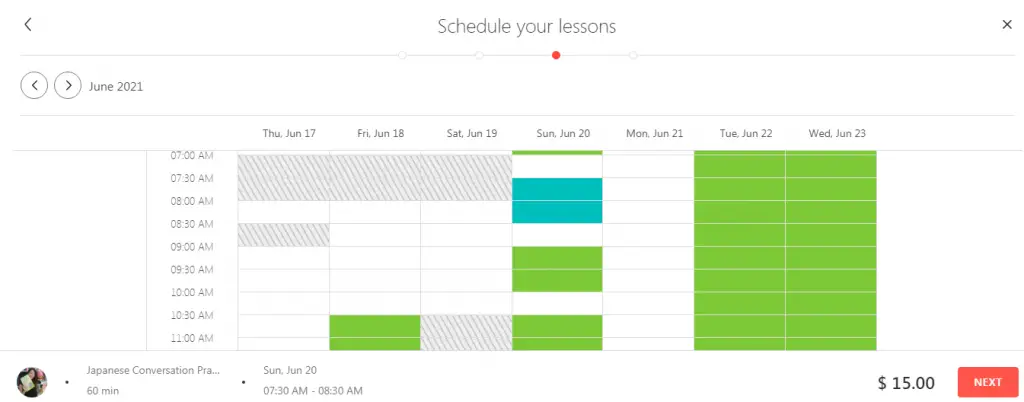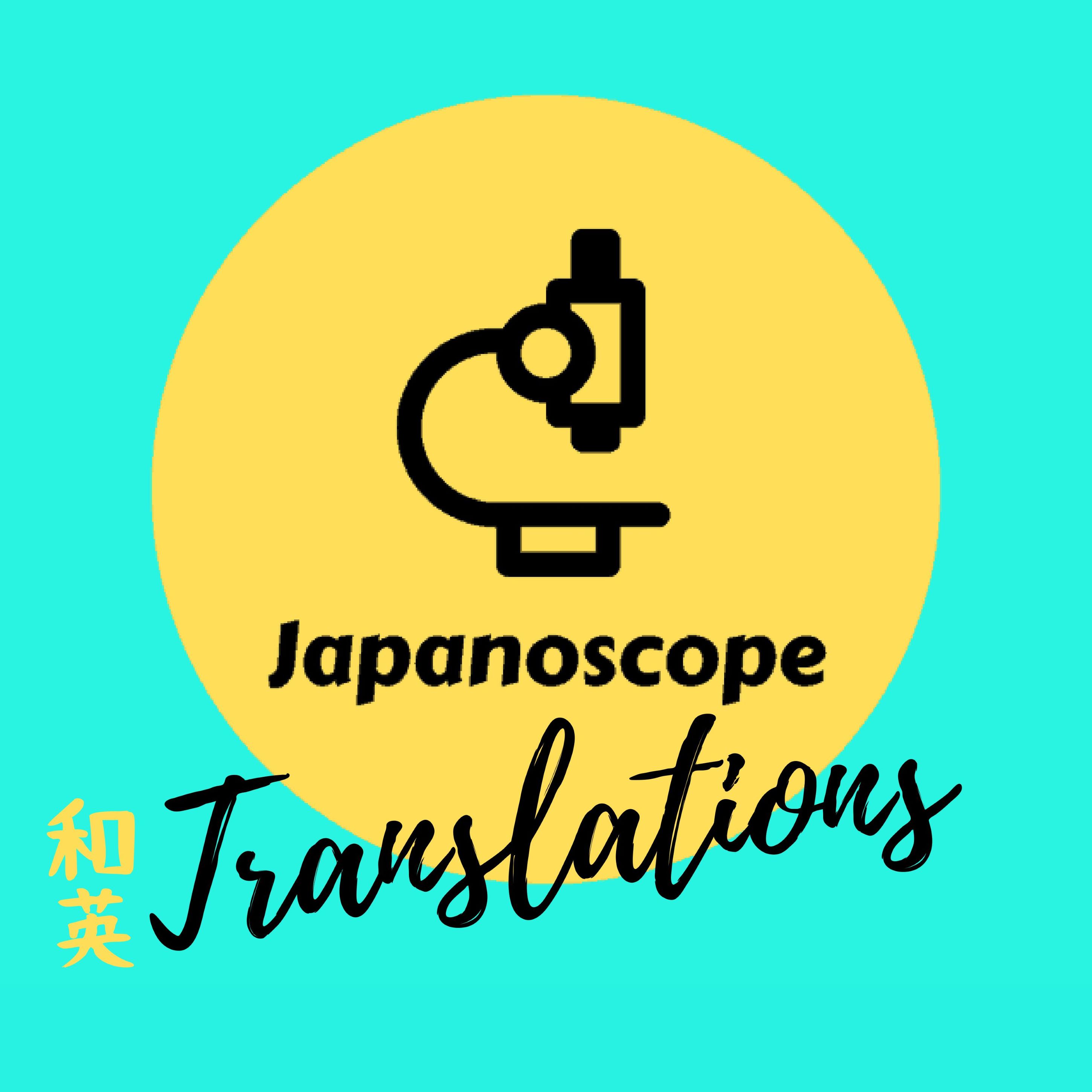Learning Efficiency
Price
Ease of Use
My Experience Using iTalki for Japanese
I have been using the iTalki platform for learning Japanese, and teaching English, for over a year now, so I thought it would be writing about my own experiences using the platform.
I had been learning Japanese for about a year, using a range of different programs like Duolingo , Maggie sensei and Marshall’s site.
I was making great progress with my reading, and even getting a bit better at listening to Japanese. I was focused on JLPT, but soon came to realise that my Japanese skills were so focused on reading and listening that I had neglected perhaps the most important element – speaking!
So I started to really look into what options were available for practicing speaking Japanese. I tried Hello talk, Discord and Telegram to talk with native Japanese people. These were useful to a point but, for me, finding iTalki was a game changer. There actually aren’t that many sites that do online Japanese speaking practice well so italki has been a gem.
When I first found iTalki I decided to jump in to give it a go.
I soon realised how weak my speaking was! I felt like even if I were to pass the JLPT exams with good grades, if it came to something like a job interview situation in Japan, I would struggle.
So I signed up for a bunch more iTalki sessions. After doing 10 classes I felt like I was starting to be able to form Japanese sentences clearly in my head. After 15 classes I was able to understand a lot more of what the speaker was trying to say. Of course, there was still plenty of vocab coming up that I just still didn’t know.
After 20 classes, matched with some pretty intense study using some of my other Japanese language resources, I guess I was getting my speaking level up to around a Japanese N2 level. I felt like the two methods were really working in tandem.
I liked that you can choose your own teacher and you can schedule the class at your own convenient time. After some Japanese speaking sessions my confidence improved and now I am not afraid of speaking in Japanese.
Is iTalki good for learning Japanese?
In a word, yes! I was directly learning from a native speaker, so it felt very useful to me. The teachers taught me about the culture of Japan, like how to prepare for an interview with a Japanese company, what to do and what not to do when speaking with a native Japanese speaker. I also found it helpful that manyiTalki teachers have good English. So if I got stuck, I was able to tell them what I wanted to say in English and they would translate it into Japanese. From there they would teach me how to say the equivalent word in english, it’s meaning and it’s Kanji reading, also which other words I might be able to use in different situations.
My confidence grew after every iTalki class. I found myself eagerly waiting for each class! If I made a mistake my tutor would correct me so that I wouldn’t make the same mistake again next time.
So what is italki?
Compared to other websites that aim to give you the ability to chat with native Japanese speakers, iTalki gives you a truly live experience of Japanese conversation, usually with native speakers. Speaking Japanese in a 1 to 1 conversation can actually be very tough, but this is what you need to learn a language. I find that for things to stick, I have to apply what I’ve learnt. Just book in, turn up and get talking.
It is worth mentioning there are many more languages which you can learn on iTalki.
I liked it so much I got involved as a tutor on iTalki by teaching my own native language!
How does italki work?
- Select the Language which you want to learn.
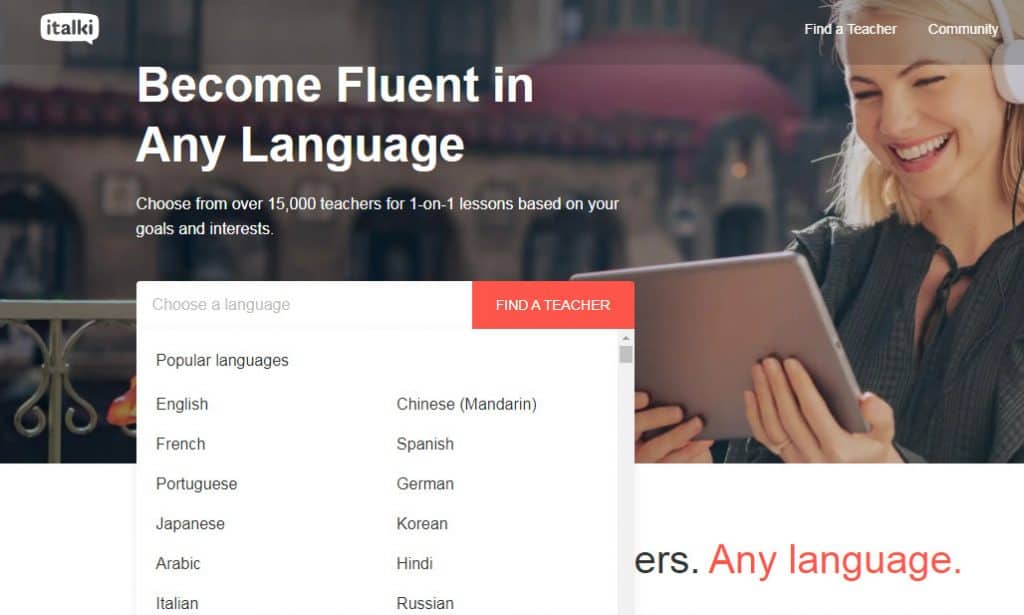
- Select the tutor which you think would be suitable for you – more details on how to do it below.

3. After selecting the tutor, select the lesson type. There are many lesson types – everything from
casual conversation practice, to formal exam orientated tutoring to more niche pursuits like singing!
4. Select the date and time you want the class.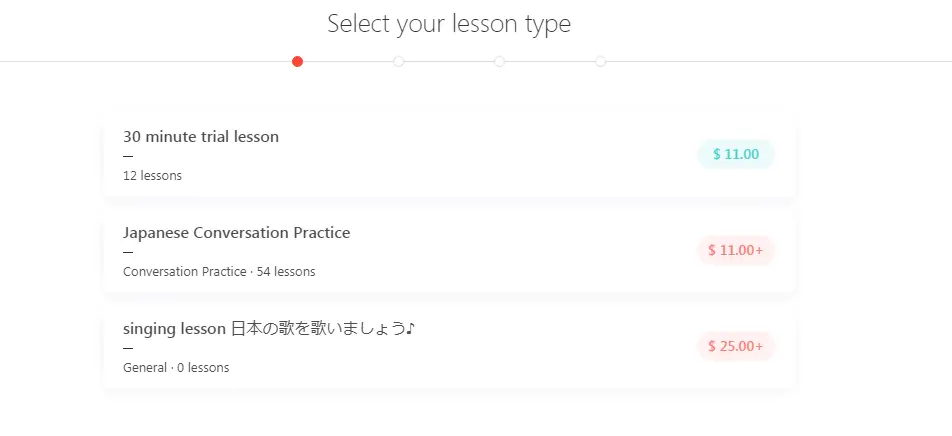
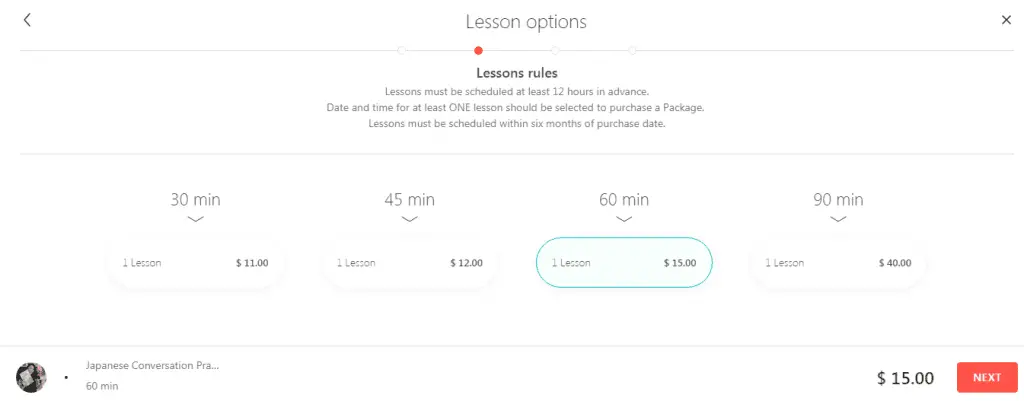
The blue bars are the selected date and time and the green ones are the available slots.
- Select your Communication tool i.e Zoom or skype or iTalkiclassroom. This is really just personal preference, I’ve found they all work pretty well!
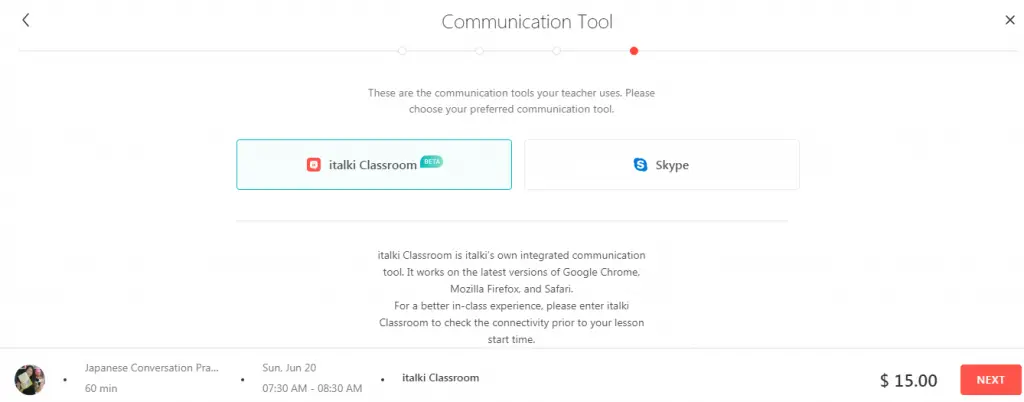
Some tutors will have the zoom option and some won’t
- Pay for the class and you will get an email of class confirmation.
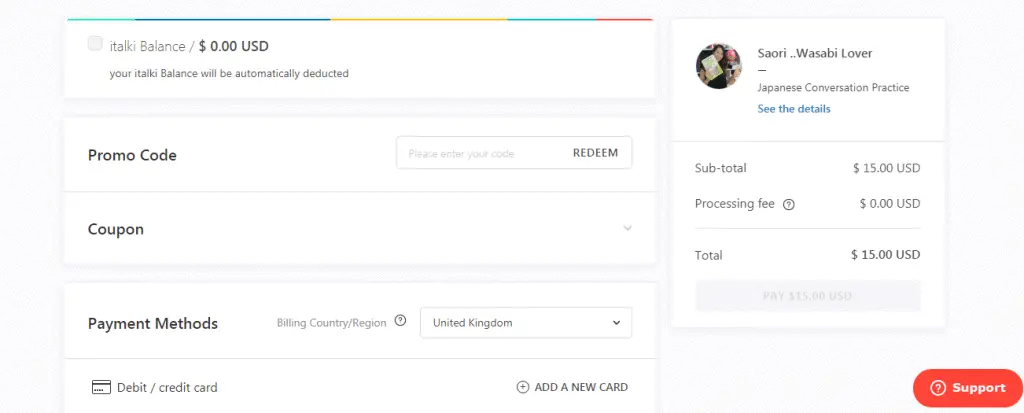
If you have a discount code you can use it (look out for these around days like Black Friday). You can pay via Debit or credit card, paypal, bank transfer etc.
How much does iTalki cost?
There are different types of classes and different types of teachers. Depending on the type of lesson
the tutor can charge you below is a rough list of the fees taken by 3 tutors:
Tutor name | Lesson plan | Charge | Hourly Rate | Trial |
Asami Sensei | 30 minute trial lesson | $6.5 | $12.00 | $ 6.50 |
Conversation practice | $7.00+ | |||
Aki Sensei | 30 minute trial lesson | $ 8.00 | $15.00 | $ 8.00 |
Conversation Practice | $10.00+ | |||
Japanese for beginners …without using textbooks | $15.00+ | |||
Packege lesson for begginers/JLPT course ×5 | $15.00+ | |||
JLPT対策コース(N4,N3,N2) | $15.00+ | |||
For a kid —Age 6~【25min or 40min ONLY】 | $10.00+ | |||
Package lessons for specific students(using GENKI textbook) | $20.00+ | |||
Kei Sensei | 30 minute trial lesson | $3.00 | $10.00 | $3.00 |
General conversations-Any levels are welcome! | $6.00+ | |||
Lesson Package | $6.00+ |
As you can see, different tutors have different lesson plans and they charge you accordingly.
For me, having a general conversation at some pretty low prices felt like a steal!
Before booking a class I always go for a 30 minute trial. This was usually enough time for me to get a sense for whether or not the teacher and I were going to click. For learning grammar and more formal study, I go to youtube or other websites. I apply that knowledge while speaking with my tutor and get my tutor to correct me.
Best Way To Use iTalki
Beyond simple one to one Japanese conversation practice, there are other options to try. If you’re interested in Manga and Anime, you can find a teacher that focuses on these, or ask an existing tutor to help you explain things to you. If you are planning on visiting Japan, you can ask your tutor to tell you the best places they think you should visit – in Japanese.
Personally, I have tried asking my tutor about Japanese festivals, and what I should and shouldn’t do if I visit one. My tutor told me that there are different festivals for different seasons and locales. They explained to me about traditional Japanese wear associated with the festivals, and about the street food and games stall.They advised me to watch the fireworks or a parade if there was one!
I also asked my tutor how they managed to remember so many Kanji as a child. My tutor told me that in Japanese schools they are taught Kanji with Kunyomi and Onyomi reading from Junior High school and that they have a weekly test for Kanji. She said it is easy for them to remember Kanji because they are surrounded by Kanji in TV shows, at the shopping mall, and in books.
For me the best way to use iTalki is to really get stuck into experiencing casual speaking. I also used it as an opportunity to experiment with role playing using different levels of politeness in Japanese. I make this clear with my tutor at the start of the lesson. I’ve found this to be really helpful in improving speaking the many different levels of politeness required to be a fluent Japanese speaker in various situations.
Do you need a Japanese language tutor?
I feel that an online tutor is indispensable for getting a good command of the language if you are not living in Japan. Japanese listening and speaking is hard. Japanese has a lot of words that have the same sound but a different meaning e.g. 会います And 合います. The only way to get proficient at navigating this in real time, is to actually spend time conversing in the language!
Having a Japanese language tutor helped me to start picking up on elements of the language more “instinctively”, such as the difference between the particle は and が. As I spoke with my tutor daily, I found myself unconsciously creating Japanese sentences in my mind. After a few months, I had learnt enough vocabulary that I started using them more freely in my daily sentences without consciously trying to construct a sentence in my mind.
I had found the main problem with textbook examples was that the subject was already spelled out clearly for you. This is not so in real conversation. This is especially an issue with japanese,
where subjects and objects are often omitted from a
sentence.
When should I start using iTalki?
I started to use iTalki when I was in N3 level around 270 days after I started learning Japanese, and by this time I felt like I had a good base to build on for my conversation sessions. You really could start out at any level, but most people find they get more out of it if they at least have a certain base level of vocab before they dive in.
How to choose a teacher on iTalki?
Step 1: Figure out exactly what you need from your online tutor.
Are you a total beginner, or stuck at an intermediate stage?
Do you have a concrete goal (to prepare for a trip, to converse with your mother-in-law, or to navigate a business meeting?)
Or are you just learning for fun?
Figure out what you want to get out of these lessons. This will really guide you as you are trying to do what is, often an overwhelming, search for a teacher. A lot of teachers offer specialisations, so this can whittle things down for you as a first criteria.
Once you do find a teacher that suits your goals, let the teacher know BEFORE your first lesson (send him or her a message through the italki platform) to make it 100% clear what you want to get out of the session/s.
If the teacher is top quality, they will prepare a lesson plan and some ideas before you first meet.
Step 2: Choose a Community or Professional tutor
If you want to practice conversation, maintain a language you don’t want to forget, or if you want to guide the lesson yourself (for example, maybe you have a document you need to understand for work, a drama program you’re struggling to understand) then choose a community tutor.
Community tutors are cheaper, because they’re not expected to prepare a lesson plan. They’re just a fluent speaker willing to chat with you and follow your lead.
In my experience, I have used mostly Community tutors as I just wanted to practice general Japanese speaking. If you want a more structured and targeted Japanese lesson you need to choose a Professional Tutor.
Professional tutors are particularly good if you are studying for a specific exam, like the Japanese Language Proficiency Test. Even if you’re not sitting a test but want to really drill your Japanese grammar, a pro tutor is probably the way to go.
Step 3: Check the number of lessons the iTalki teacher has taught
One of my main criteria when choosing a teacher is who has taught the most lessons. I’ve noticed that teacher’s experience levels make a genuine difference in how good their lessons tend to be. These tutors have done their “flight hours”, and they often have more resources to work with. The fact that they have been going for longer than others shows that they are, at very least, teaching at a “sustainable” quality level to maintain students.
Step 4: Final step
The last step is the simplest, find a date that works!
Sometimes this can be easier said than done, as popular teachers can be in high demand. Others you can book in with straight away.
Recommended Japanese Teachers on iTalki
I have tried quite a few teachers, many of whom have been very good, but one of my favourites was Kikou. She’s quite expensive compared to others, but I find her interesting, funny, knowledgeable, and was always up for fielding the strange questions I came up with.
Our sessions were freeform, with some reading aloud practice. She was pleasant to talk to and good at keeping the conversation going. I really like that she never interrupted me when I was talking, then corrected what I said after I finished.
I started my lessons with her somewhere between level N4-N3, when I was still a disaster at speaking;
and am still using her now that I’m somewhere around N3-N2 and can hold a conversation.
How much do italki teachers make?
I have been able to sustain an hourly rate of around $19, and am looking to be over $20 moving forward.
When I first started on iTalki, it was pretty slow. In fact, iTalki recommends that you start charging a low amount to get new students and then work your way up. Unfortunately, this creates a “race to the bottom” mentality on Italki, with a number of teachers charging as little as $8 for a one-hour lesson (but I think the quality tells). This is one the the downsides of Italki. Anyway, I earned around $87.55 in my first month, working 6.5 hours. This works out to $13.47 dollars an hour. It’s not minimum wage in my state, and it’s also not paying my bills!
In the second month, it wasn’t much better, with only $182.75 for 11.25 hours worth of work. In the third month, I moved up to around $351.90 for 20 hours of work. While my hourly rate went up by $4.13, I still wasn’t working enough hours to make this a full-time job. What was wrong? Was it my video? Was it my profile?
Since then the income has been pretty steady. Overall, the trend has been looking good. The only significant dips in my income were due to the holiday season in December and my hard drive crashing in April. Otherwise, I have reached an hourly rate of around $19, and am looking to push that to $20 an hour from this point forward. If I worked on the weekends (Fridays and Saturdays), I think that I could easily make over $2,000 a month on iTalki. However, people need to recharge, and I am no different. Still, having a 25-hour work week is pretty much the norm on iTalki.
Things to watch out for on iTalki
You need to be wary of the cancellation policies of different tutors.
You also need to take a look at their teaching styles and the reviews before booking the class. If you have any doubts, it can’t hurt to contact the teacher before booking a class to sound things out. Once I wanted to ask a question from a Japanese textbook, but my tutor didn’t allow me to bring my own materials! So you need to watch out for any “red flags” in relation to the teacher’s details. Always ensure that you are learning in every class. If you aren’t learning anything, don’t be afraid to change the tutor.
Check the zoom connectivity and skype connectivity of your tutor. If there is a network problem regularly then change the tutor or ask them to solve the issue. I had a tutor once where, out of 60 mins, at least 10 to 15 minutes were wasted because of network issues.
Is italki safe?
Yes, in my experience it has been safe. But I am also aware that I am a male student, so others may have a different experience.
It is worth remembering that you have the option to do your lesson with the camera off if that is more comfortable for you. Don’t be afraid to reach out to iTalki management if you experience something untoward!
On a purely financial level, as a tutor I sometimes received late payment from italki and found that they sometimes seemed to take unusually high commissions from my payments. But overall, I would recommend iTalki as a safe and friendly platform.
iTalki alternatives
If you want to compare iTalki to the competition you might want to check out:
1. Verbling
2. Hellotalk
3. Cafetalk
I am listing 2 of the iTalki alternatives which I have used and sharing my experience with you.
- Verbling
Verbling is the biggest competitor to iTalki and they provide a platform that is similar in most ways, but with a few differences.
I think Verbling’s payment system and the overall platform has the edge over italki’s. You’re able to pay for the class without the need of adding money into your account’s “wallet” first. Classes also take place within their platform so you don’t need to switch to Skype for the lesson itself.
2. HelloTalk
HelloTalk is also a very great alternative to iTalki.
Unlike on iTalki, where you need to pay the tutor and arrange a class, HelloTalk provides you an opportunity to quickly long and talk with native speakers in real time, chat with them and ask them questions for free. Hello talk is like a social networking site where you can post a story and receive comments and likes.
I have many native Japanese speakers on HelloTalk who have become my good friends. I talk with them on calls as long as I want.
Unlike iTalki, audio-only calls are common on HelloTalk. There are many language learning groups which consist of native speakers and learners, where you can hang out and chat. You can ask anything about the language in a story and the native speakers will reply to you to explain. I personally enjoyed Hello talk more than iTalki and as an English teacher. Teaching on HelloTalk is a hassle free process, different to iTalki where you need to set the price and make an introduction video The HelloTalk team will give you the details of the student and you can talk with your student on zoom or skype for a rate of around $10 for 1 hour. So for ease of use, Hello talk is a great alternative to iTalki
Concluding Thoughts on iTalki
I’m a fan of iTalki. When I wanted to improve my conversational skills, iTalki helped me to improve my speaking. I wouldn’t recommend it so much for beginners, but once you reach an intermediate level you can use iTalki to really boost your speaking and listening skills. With a great variety of Native speakers as tutors I polished my Japanese speaking skills and achieved a level of confidence while speaking Japanese.
Overall, I had a very good experience using iTalki and liked the quality of the tutors. I would definitely recommend iTalki if you want to improve your conversation skills over the long term.
Other Japanese Language Resources & Reviews
See our complete Japanese Language Learning Resource List
or our Japanese language learning platform reviews below:
- Japanese Pod 101 Review – All-in-one, audio & podcast focused course with HEAPS of content.
- Rocket Japanese Review – A solied, systematic, wholistic Japanese course.
- Pimsleur Japanese Review – A listening focused Japanese language course with the longest track record and a scientific approach.
- Memrise Japanese Review – Customizable, Spaced Repetition & flashcard influenced Japanese courses
- Duolingo Japanese Review – Gamified, Spaced Repetition and AI enhanced course of bite sized lessons.
Japanoscope uses affiliate links. Which means we may receive commisions when you click on some product links. We only link to products we believe in, use ourselves or think are genuinely good. This helps us keep all of the content on the site free of charge. As Monty Python once said, “We’re selling records in the foyer. Some of us have gotta eat too you know”.
Language Learning Program Reviews
Contributor
Karan Belani is a avid student of Japanese and is working towards a career in technical translation for Japanese tech companies.

